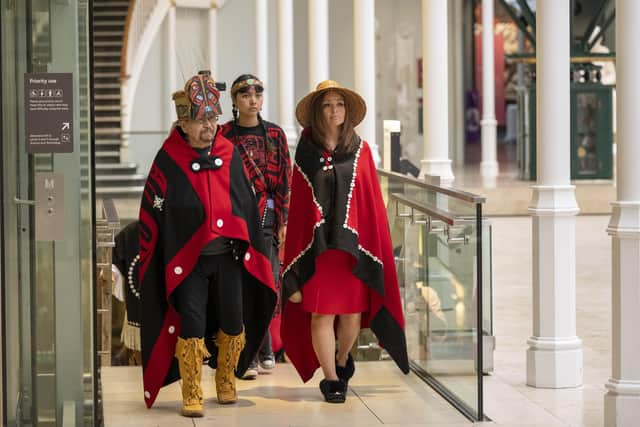Last chance to see 'stolen' totem pole as Scottish museum starts removal work ahead of return to Canada
and live on Freeview channel 276
Work is under way to remove a "stolen" totem pole after nearly a century on display at a Scottish busiest visitor attraction and return it to its place of origin in Canada.
The public will be able to get final glimpses of the 36ft tall wooden artefact at the National Museum of Scotland for the next few weeks while work goes on to move other objects and display cases in one of its main gallery spaces.
Advertisement
Hide AdAdvertisement
Hide AdThe Ni'isjoohl Memorial Pole, which can be seen from the balconies above the temporarily closed Living Lands gallery, is to be encased in a bespoke steel frame and a scaffolding tower to ensure it can be safely removed from the museum in September.


The work has begun exactly a year after a delegation of indigenous Nisga's Nation representatives visited Edinburgh to make a personal plea for its journey to the Nisga'a Museum in the Nass Valley in what is now British Columbia.
It was described as “priceless belonging that our respected hereditary leaders have aptly called a cultural treasure.”
At the time, a spokesman for the delegation said: “The pole was taken without the consent of the House of Ni’isjoohl, during a period when the Nisga’a Peoples were away from their villages for the annual hunting, fishing, and food harvesting season.”
Advertisement
Hide AdAdvertisement
Hide AdThe Ni’isjoohl Memorial Pole was carved from red cedar in 1855 by artist Oyea Tait and his assistant carver, Gwanes, in memory of Ts’aawit, a Nisga’a chief.The pole, which was sold to the museum by Canadian anthropologist Marius Barbeau in 1929, originally stood in front of the house of Ts’aawit’s relatives in Ank’idaa village on the banks of the Nass River.


Sigidimnak’ Nox Ts'aawit (Dr Amy Parent), Canada research chair in indigenous education and governance at Simon Fraser University in Vancouver, said: “To have had it taken from us is to have removed a piece of our cultural identity and an integral part of the story of our nationhood.”
The historic move to return the memorial pole was agreed by the board of trustees at the museum and the Scottish Government in December.
Chanté St Clair Inglis, head of collections services at the National Museum, said: “We have been planning the lowering and transfer of the Ni’isjoohl Memorial Pole since the request for its transfer was approved in December.
Advertisement
Hide AdAdvertisement
Hide Ad“Lowering and moving the memorial pole out of the museum requires a complex series of tasks.


“In order to do that safely, we have to first create space around the pole. We are currently temporarily relocating objects and display cases to create that space.
"We will then build a scaffold around the pole and use it to fit a steel cradle which will keep the pole protected throughout its move.
"The pole will be safely lifted and lowered, moved through the museum building and then out of a large window, and from there safely onwards to the Nisga’a Nation in British Columbia
Advertisement
Hide AdAdvertisement
Hide Ad"We are undertaking this complex work with the greatest of care taking into account the pole’s age, and size, and in collaboration with the Nisga’a nation as part of our positive ongoing dialogue with them.
"While we're doing all this work, people still have the opportunity to come in and see the memorial pole from the balconies above.”
Comment Guidelines
National World encourages reader discussion on our stories. User feedback, insights and back-and-forth exchanges add a rich layer of context to reporting. Please review our Community Guidelines before commenting.
